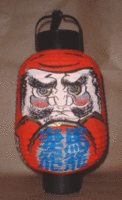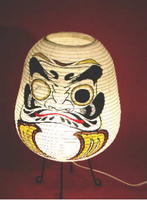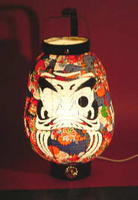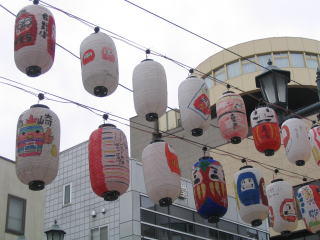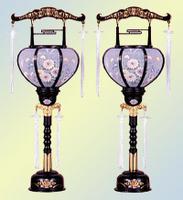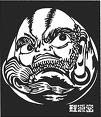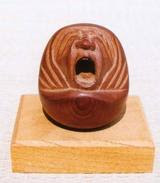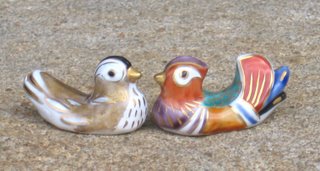:::::::::::::::::::::::::::::::::::::::::::::::::::::::::::::::::::::::::::::::::::::::::::::::::::::
- - Washi 和紙 Japanese Paper - -
http://www.tesukiwashi.jp/p/yoto_daruma.htm
This store has a great collection of links to Washi Paper and the various products made from it.
http://www.tesukiwashi.jp/p/washiseihin.htm
.. .. .. .. .. .. .. .. .. .. .. .. .. .. For example
はがき Hagaki, postcards
便箋・封筒 fuuto, envelopes
ランプシェード Lampshades
名刺 Meishi, Business Cards
色紙 shikishi, colored paper
人形・壁掛など Dolls and decorations for the wall
.. .. .. http://www.tesukiwashi.jp/image/echizen/echizen_ningyo.gif
.. .. .. http://www.tesukiwashi.jp/image/echizen/echizen_kabekake.jpg
座ぶとん(黒谷和紙) Zabuton, Seat cushions
Nr. 9 of these dolls is a Hime Daruma, Princess Daruma:
http://www.tesukiwashi.jp/image/ecchu/ecchu_kataezome.gif
Dolls for "Kaze no Bon" Festival
http://www.tesukiwashi.jp/image/ecchu/ecchu_kazenobon.jpg
This goes on and on...
:::::::::::::::::::::::::::::::::::::::::::::::::::::::::::::::::::::::::::::::::::::::::
quoted from
.. .. .. .. .. .. .. Japan's Encounter With Paper
The Japanese people's sentiment that transcended the original use of paper
The oldest printed matter existing in the world are the "One Million Dharani Charms" of Japan. In the year 764, the Empress Shotoku, praying for peace throughout the nation, sanctioned the printing of a million paper prayers, each prayer to be enshrined in its own individual three-storied wooden pagoda with a height of 13.5 centimeters and a diameter of 10.5 centimeters at the base. Printed Buddhist prayers called Dharani were placed in a hole in the center and 100,000 each of these pagodas were allotted to ten great temples, including the Horyuji Temple of Nara, Yamato Province.
At a time when paper making techniques made a rapid advance, the Japanese people were not satisfied with simply paper on which words could be written and which could be preserved well. They demanded a special harmony and beauty, depending on the use and the taste of the user. Just for "irogami" (colored paper) and "tanzaku" (strip of fancy paper for the writing of poems) alone, many different kinds were made, ranging from the ornate to the simple, to match the poem's content and calligraphic style. The complex demands were fully met by the paper making artisans.
Washi was often used as a gift among the upper classes of society in ancient times and the Middle Ages. For instance, when members of the nobility visited each other, it was customary to take along white paper of high quality. This was presented with the thought that the person visited was a man of culture-so please use this for composing poems or copying a sutra." This refined custom continued until recent times.
Even on the battlefield, it was considered good taste for a warlord to carry thich Washi called "hikiawase" with him. The original meaning of "hikiawase" was the place for tightening body armor. It was usually located on the body armor's right side. Warriors found it convenient to put paper and writing equipment here and it was from this that the name of the paper originated. Besides for official communications, the paper was used for writing poems, miscellaneous notes and records.
Choths made from Washi
Eventually the uses of Washi spread beyond writing, painting and printing. Washi was the first paper in the world to be employed widely for daily necessities. Washi imparted many benefits and had a splendid practicability in the life of the Japanese people as a whole.
When well used Washi is torn into a ribbon-like form and twisted with the hands, this becomes what is known as "koyori." It is generally used as a string to bind sheets of paper. In addition, a large number of "koyori" can be combined in different shapes and lacquered for "koyori handiwork."
The many kinds of "koyori handiwork" such as bowl, plate, cigarette case, lunch box and "kori" (hamper with cover for containing clothing-made with consideration for ventilation) are lightweight and splendid craft work. It is a traditional industrial art born out of the attachment felt by people who did not want to waste even a fragment of Washi.
This is an amazing article on three pages,
please look at the big pictures and read the original here:
http://www.jgc.co.jp/waza/b4_washi/washi01.htm
About the making of Washi
http://www.jgc.co.jp/waza/b4_washi/washi03.htm
Safekeep copy is here:
http://groups.yahoo.com/group/DarumaArchives-002/message/55
:::::::::::::::::::::::::::::::::::::::::::::::::::::::::::::::::::::::::::::::::::::::::::::::::::::
--- Material used for Washi
choshi 楮紙 mulberry tree paper
hishi 岩菲紙 / 雁皮紙 (がんぴし)
Ganpi plant, Wikstroemia Sikokiana
mashi 麻紙 hemp paper
mitsumata 三椏紙 Edgeworthia chrysantha (J. mitsumata)
:::::::::::::::::::::::::::::::::::::::::::::::::::::::::::::::::::::::::::::::::::::::::::
Another informative page about Washi Paper.
Washi is the Japanese word for the traditional papers made from the long inner fibres of three plants, wa meaning Japanese and shi meaning paper. As Japan rushes with the rest of the world into the 21st Century, and more modern technologies take over, machines produce similar-looking papers which have qualities very different from authentic washi. As of the fall of 1994, there remain roughly 350 families still engaged in the production of paper by hand.
History
Raw Materials
Methods of Production
Features of Washi
Uses for Washi
http://www.japanesepaperplace.com/abt-japanese-paper/about-washi.htm
Something for everyone...
Who uses these papers? The sky's the limit! But here are some whose work can greatly benefit:
Artists
Bookbinders
Conservators
Craftspersons
Graphic Designers
Interior Designers
Manufacturers
Painters & Drawers
Printmakers
As time goes on, modern technology replaces much of the traditional process. Still there are those papermakers left who will not compromise.
According to the Japanese, "Things of excellence shall not die."
:::::::::::::::::::::::::::::::::::::::::::::::::::::::::::::::::::::::::::::::::::::::::::
The Great Washi Paper Sculptor,
Uchiumi Kiyoharu 内海清美
Uchiumi made a show of washi puppets relating to the life of Kuukai, Kooboo Daishi (Kukai, Kobo Daishi).

. . . CLICK here for Photos !
■内海清美の物語空間 和紙人形による空海の世界
The world of Kukai, made of Washi Paper
One example, Chapter 10
第十章 即身成仏
嵯峨天皇は南都六宗と北嶺(比叡山)の高僧、および空海の八人を宮中の清涼殿に召集、それぞれの宗旨の真髄を聴聞します。これは八宗論として伝えられています。 その場での各宗の高僧は、すべて成仏の経路は三劫成仏[さんごうじょうぶつ]といって、長い年月の修行を果たした後にはじめて成仏できるという未来成仏を説きます。 これに対し空海は一人「自心の源底を知るものは仏の心を知る。仏の心を知るものは衆生の心を知る。仏の生命を覚り、これと一体化して生きる肉体そのままで速やかに仏になることができる。それは仏の三密と人間の三業とが不二になる境地である」と真言宗の即身成仏を説き、一座の天皇と高僧たちの前で、手に印契を結び、口に真言を唱え、心を仏の三昧に住するという三密行を示し、自身金剛身(大日如来)となり即身成仏の境地に入ってみせ、体から黄金の光を放ちます。 他宗の高僧たちはこの光景にすっかり畏敬し、天皇の空海への信頼は一層高まります。
quoted from mikkyo21
There is a Museum with the Sculptures of Uchiumi san.
Genji Paper Sculpture Museum
This museum exhibits Japanese paper carvings and sculptures of Mr. Kiyoharu Uchiumi. He has reproduced some scenes from the Tales of Genji, which is the masterpiece written by Murasaki Shikibu in the Heian period.Mr. Uchiumi's aim is that visitors appreciate his works with all their five senses. Lighting and music complement and allow full expression of his works The entire exhibition hall is a big stage, and the spectators walk by and appreciate individual scenes on the stage.
http://www.archphoto.it/IMAGES/asia/hayakusa/mats.htm
:::::::::::::::::::::::::::::::::::::::::::::::::::::::::::::::::::::::::::::::::::::::::::::::::::::
. Asakusagami, Asakusa-gami 浅草紙 .
Paper made in Edo
kamisukishi、kamisuki shi 紙漉き師 making paper, paper making artisan
kamiya, kami-ya 紙屋 paper maker
- Kamisukichoo 紙漉町 Kamisuki-Cho district
sukikaeshi, suki-kasehi 漉き返し業者 re-making of paper
:::::::::::::::::::::::::::::::::::::::::::::::::::::::::::::::::::::::::::::::::::::::::::::::::::::
Echizen Washi 越前和紙 paper from Echizen
Otaki Jinjya 大瀧神社
Okata Jinja 岡太神社
福井県今立郡今立町粟田部 Fukui
Shrine for the deity of washi paper
Taketsunomi 建角身(たけつのみ)命
Kunisatsuchi 国狭槌(くにさつち)尊
Oonamuchi 大己貴(おおなむち)命

source : www.echizenwashi.jp
quote
History of Echizen Washi
A paper goddess teaching people how to make paper
Legend has it that about 1,500 years ago a woman taught people in this area how to make paper with the natural materials from special plants for washi called Kozo, because she had sympathy on them since they did not have any rice fields to make a living. She mysteriously disappeared to the upper river, so she was named "Kawa-kami Gozen", meaning "upriver princess" in Japanese.
Since then, the princess has been enshrined as a paper goddess with two local gods in Okamoto Otaki Shrine.

川上御前 Kawakami Gozen, deity of washi paper 紙祖神
They say she might have been from Korea or China.
Around that period, there had been many people from China passing through Korea to bring their techniques to Japan, which later became the present Japanese handcrafts. The Fukui accent is very similar to the Korean one, due to the fact that Fukui was one of the main locations Koreans could first land on naturally with the strong tide of the sea. When they landed, they only found a vast swamp, which made it difficult for them to settle in. As a result, they went to the surrounding mountain valleys to live. These locations are the origins of where pottery, lacquerware, knives and Washi (Japanese traditional paper) are made, according to some studies.
Since then Washi has been a main industry in the Echizen area. There are now about 70 factories that use either handmade, industrial, or processing methods, with about 500 people working in Washi related jobs in the Imadate area "Goka".
五箇地区
"Goka" is called by five villages of the town, Oizu, Iwamoto, Shinzaike, Sadatomo and Otaki, in all together. This area have been producing Japanese paper since 6th century and constitute "Echizen Washi no Sato".
There used to be lots of paper villages every where in Japan, but it is veryunusual to see an area like Echizen only making paper through all the year, whereas the others used to make paper only in winter when they didn't producerice. As a result, Echizen is one of the largest handmade paper industries in Japan along with Tosa in Kochi and Mino in Gifu Prefectures.
The Royal family sometimes uses Echizen Washi to announce their baby’s birth with their names on it.
Here, there are many old people interested in Echizen Washi history and keep studying with the old documents by themselves. The above-stated are from my own studies taught by some of them. Now I am studying about the exported paper from Echizen during the edo period, when the central government closed most of the ports but Nagasaki only open to China and Holland.
source : www.echizenwashi.jp/english
:::::::::::::::::::::::::::::::::::::::::::::::::::::::::::::::::::::::::::::::::::::::::::::::::::::
Paper from San-In 山陰 - Tottori and Shimane
Izumo and Inaba
Inshuu washi 因州和紙 Inshu Washi

quote
Inshu, also called Inaba, is the feudal name for an area that today lies in the eastern part of Tottori Prefecture. Today the production scale of Inshu washi (Japanese hand-molded paper) at two towns of Aoya Town and Saji Village in east Tottori Prefecture is second in Japan only to that of Echizen washi in Fukui Prefecture. In a region blessed by top-quality water that comes from crystal-clear streams deep in the mountains, the successful history of Inshu washi stretches back more than 1,000 years.
..... The high-quality calligraphy paper has long been prized for the way in which it subtly enhances the shading in the flow of the ink, and Inshu washi remains one of the country's most sought-after papers for calligraphy. ...
source : web-japan.org
. Folk Craft and Art from Tottori .
.................................................................................
Izumo Washi 出雲和紙 Washi paper from Izumo

quote
Izumo Folkcraft Paper
The Izumo region, in the West part of Japan, has been documented as a paper production area since ancient times.
Former Living National Treasure Eishirou Abe built upon this local tradition, and with the counsel of the founder of the Folkcraft Movement Soetsu Yanagi, established Izumo Folkcraft Paper.
Currently, the spirit and skill of Eishirou Abe has been passed to his grandsons, Shinichirou and Norimasa Abe.
..... In 1983, Mr. Abe established "Abe Eishirou Memorial Hall", where a wide and varied collection of literature and materials related to Washi, and many items made of Washi are exhibited. Next to the Hall is the Washi Denshusho Hall where individuals can personally experience the Japanese handmade papermaking process.
Raw Materials for Japanese Papermaking
In Japanese papermaking, a wide variety of fibers are used, but originally, fibers such as hemp, kozo, and gampi were prevalent. During the Edo period (1600-1868), mitsumata began to be used, and currently, kozo, mitsumata and gampi have become the typical fibers used for Japanese papermaking. Other suitable fibers for papermaking include straw, kuwa, bamboo, and wood pulp. Also, in recent years, the use of imported Thai kozo, Philippine gampi, and Manila Hemp (Abaca) is increasing.
Gampi (Diplomorpha Sikokiana Honda)
Kozo (Broussonetia Kazinoki Sieb)
Mitsumata (Edgeworthia Chrysantha Lindle)
source : www.mable.ne.jp/~mingeishi
quote
The decrease in papermaking households has also happened here in Yakumo-cho; this area which used to have approximately 30 mills has now shrunken to just our house, Izumo Washi.
... The true enjoyment of papermaking comes when the papermaker and the user are able to become one. It should also be said that papermaking isn’t a one-person job. At the moment, myself, my wife, my younger brother, my eighty-year old mother, an intern and two women from the neighborhood make a total of seven of us doing the work needed. I am especially thankful to my family’s cooperation at the mill. This is the secret to making great paper. ...
Shinichiro Abe
source : www.hiromipaper.com
:::::::::::::::::::::::::::::::::::::::::::::::::::::::::::::::::::::::::::::::::::::::::::::::::::::
出雲から紙来て障子あらたまる
Izumo kara kami kite shooji aratamaru
from Izumo
paper came and we renew
the sliding doors
Ameyama Minoru
The strong washi paper from Izumo was especially liked for shoji.
:::::::::::::::::::::::::::::::::::::::::::::::::::::::::::::::::::::::::::::::::::::::::::::::::::::
. shichoo 紙帳 ( しちょう) mosquito net made of washi paper
shichoo uri 紙帳売(しちょううり) vendor of the above
kigo for all summer
. Paper robes and paper making as KIGO
. Chiyogami 千代紙 colored printed paper
. kami 紙 paper art and craft .
. Regional Folk Art and Crafts from Japan .
[ . BACK to WORLDKIGO TOP . ]
[ . BACK to DARUMA MUSEUM TOP . ]
:::::::::::::::::::::::::::::::::::::::::::::::::::::::::::::::::::::::::::::::::::::::::::::::::::::

